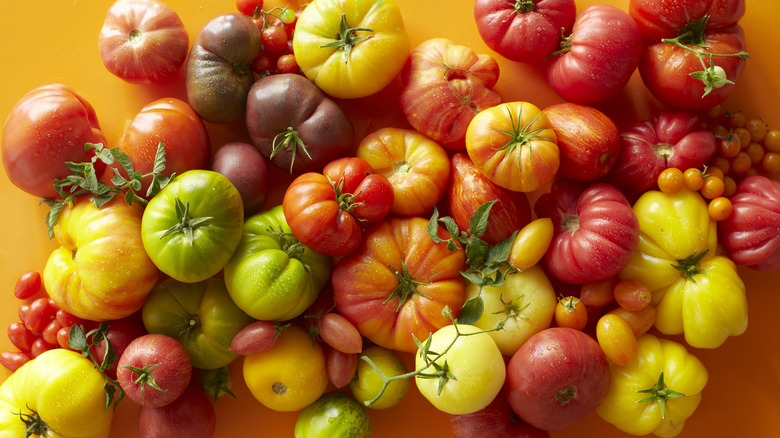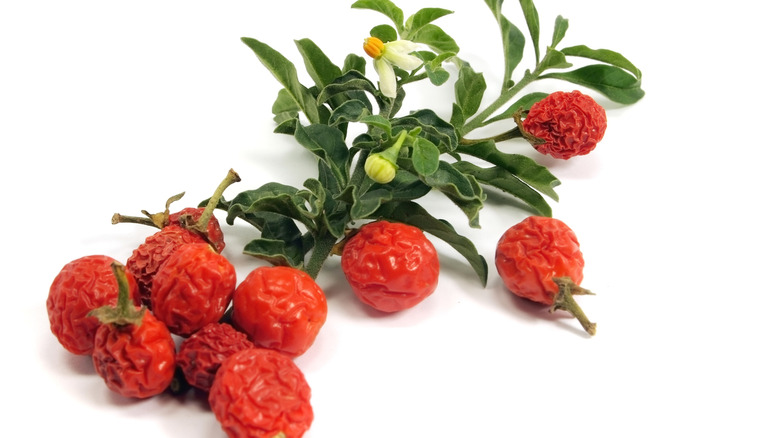Why Tomatoes Were Once Feared As Dangerous Poisonous Plants
Tomatoes are juicy, vibrant kitchen staples and the base of countless delicious recipes, but they weren't always welcomed in kitchens with open arms. In fact, these luscious fruits were once regarded with suspicion and fear. Back in the 16th and 17th centuries, tomatoes earned the ominous nickname "poison apple," as they were blamed for causing mysterious illnesses and even death among European elites. The root of this fear? Tomatoes have high acidity, which causes lead from pewter plates to leach into food, leading to poisoning. Little did people know, it wasn't the tomato's fault at all, and were they to eat any highly acidic fruit on said plates, the same would have happened. This misunderstanding tarnished the reputation of the now-beloved fruit for centuries.
There's also a prevalent idea in modern society that tomatoes made their way into the theater, not on the menu, but as projectiles. However, this Shakespearean-era tradition of tossing tomatoes at actors during poor performances is unlikely to be true as tomatoes weren't widely available. Instead, people threw rotten fruits amongst other items. Luckily for both thespians and diners, this misunderstood fruit's history took a turn for the better, landing it a leading role in global cuisine and changing it for good. Let's dig into how tomatoes went from being feared to celebrated as we explore the fearsome tomato and its dramatic past.
The evolution of the tomato's reputation
The journey of the tomato from the Americas to Europe is the stuff of culinary legend. Originally cultivated by the Aztecs and other Mesoamerican cultures, tomatoes were introduced to Europe in the 16th century after Spanish colonization, along with pineapples, papayas, chili peppers, and even cacao. However, their membership in the nightshade family didn't help their case to be edible items, as relatives of toxic plants like belladonna, a known ingredient in aqua tofana, and tomatoes were suspected of being poisonous. This fear wasn't entirely unfounded; parts of the tomato plant, like its leaves and stems, contain toxic compounds, but the fruit itself is perfectly safe to eat and cook with, as we now know.
Despite these concerns, tomatoes quietly gained popularity in certain Mediterranean cuisines. Italians began experimenting with the fruit, incorporating it into sauces, stews, and eventually, the most widely beloved food of all, pizza. By the 18th century, tomatoes were embraced in Southern Europe but remained misunderstood elsewhere. Over time, improved agricultural practices and scientific understanding debunked myths surrounding the fruit. Tomatoes' versatility and health benefits, like being rich in vitamins and antioxidants, finally earned them their rightful place at the table.
From poisonous fruit to culinary star
Fast forward to today, and it's hard to imagine a world without tomatoes. They're the backbone of marinara sauces, the heart of caprese salads, and the soul of countless cuisines. While their past is riddled with drama, tomatoes are now celebrated for their bright flavors and nutritional value. Fun fact: adding a carrot to tomato sauce can help balance its acidity and enhance its natural sweetness, a hack that even the tomato-wary can appreciate. There's no reason not to use tomatoes in everyday meals, and there's even a hack for slicing cherry tomatoes en masse, a task that has never been easier.
Some people still dislike raw tomatoes. Perhaps it's the texture, but worry not; there's a way to convert them to tomato lovers. Still, tomatoes aren't just for eating — they've transcended the plate. From their role in gardening to their ability to spark a heated debate over whether they're a fruit or vegetable, tomatoes are a testament to how a misunderstood plant can rise to stardom. So the next time you enjoy a ripe tomato, take a moment to appreciate its wild history and the centuries it took to evolve from a "poison apple" to a pantry staple.


